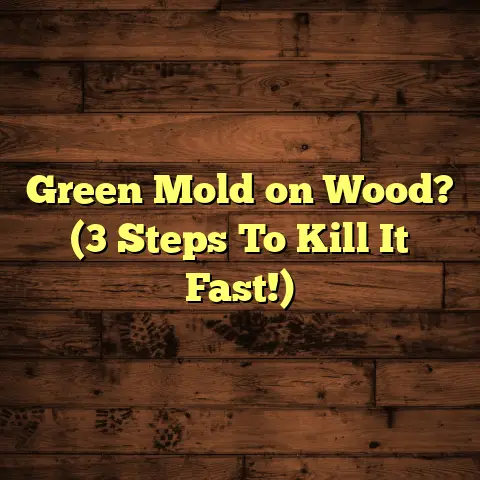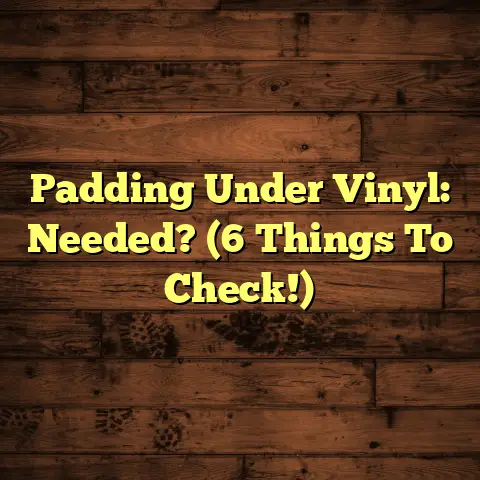Assemble Shed On Concrete? (1 Base to AVOID!)
Ever feel like your shed’s got a mind of its own? It’s like that quirky uncle who always seems to be leaning a little too far to one side.
I’ve seen sheds that look like they’re staging a slow-motion collapse, all because of one simple oversight: the base.
And trust me, after years in the flooring and construction business, I’ve seen it all.
Today, we’re diving deep into the world of shed bases, specifically when you’re putting that shed on concrete.
We’ll cover what works, what doesn’t, and, most importantly, the one base you absolutely want to avoid like it’s a bad case of poison ivy.
Understanding the Importance of a Solid Base
So, what do I even mean by “base”?
Think of it as the foundation of your shed’s tiny empire. It’s the structure that sits between the concrete slab and the shed itself.
The base does more than just lift the shed off the ground; it’s the unsung hero that provides stability, prevents rot, and keeps those pesky critters out.
Now, concrete is a fantastic starting point. It’s solid, level, and relatively easy to work with. But simply plopping your shed directly on the concrete?
Well, that’s where things can get dicey.
There are several base options out there, each with its own pros and cons.
You’ve got pressure-treated lumber, gravel pads, plastic grids, and even fancy composite materials. We’ll get into those later.
Benefits of Assembling a Shed on Concrete
Let’s be clear: concrete is a great foundation for a shed.
Why? Because it offers a ton of advantages:
-
Rot Prevention: Concrete keeps the wood of your shed away from direct contact with the ground, dramatically reducing the risk of rot and decay.
-
Stability: A level concrete slab provides a rock-solid foundation, preventing your shed from shifting, settling, or tipping over in high winds.
-
Pest Control: Concrete makes it harder for rodents and insects to burrow into your shed. Combine it with proper sealing, and you’ve got a fortress.
-
Ease of Maintenance: A concrete slab is easy to clean and maintain. No more battling weeds or muddy patches around the base of your shed.
-
Moisture Control: When installed correctly with a moisture barrier, concrete helps prevent ground moisture from wicking up into your shed.
I’ve seen sheds built directly on the ground turn into moldy, collapsing messes in just a few years. A concrete base, with the right intermediary base, is your best bet for longevity.
The One Base to Avoid: Direct Contact!
Okay, here’s the big reveal: the one base you should absolutely avoid when assembling a shed on concrete is… drumroll please… no base at all!
That’s right, placing your shed directly on the concrete slab without any kind of buffer is a recipe for disaster.
Why is this so bad?
Let me break it down:
-
Water Pooling: Concrete, while solid, isn’t perfectly waterproof. Moisture can seep through or condense on the surface.
Without a base, this moisture gets trapped between the shed floor and the concrete, creating a breeding ground for mold and rot.
-
Insufficient Ventilation: A good base allows air to circulate under the shed, helping to dry out any moisture that does accumulate.
Direct contact blocks airflow, leading to dampness and decay.
-
Structural Instability: Even a perfectly level concrete slab can have minor imperfections.
Without a base to distribute the weight evenly, your shed floor can become stressed and warped over time.
I once had a client who ignored my advice and put his shed directly on the concrete.
A year later, he called me back, complaining about a musty smell and a spongy floor.
Sure enough, the floor joists were rotting from the bottom up due to trapped moisture.
He ended up having to replace the entire floor, costing him way more than if he’d just used a proper base in the first place.
Alternative Base Options
Alright, now that we know what not to do, let’s talk about some better options.
When you’re putting a shed on concrete, you want a base that provides a moisture barrier, allows for ventilation, and distributes weight evenly.
Here are a few alternatives I recommend:
-
Pressure-Treated Lumber Frame: This is my go-to choice for most sheds. Build a frame out of pressure-treated 4x4s or 2x6s and place it between the concrete and the shed floor.
This creates a buffer that keeps the wood off the concrete, allows for airflow, and distributes the weight evenly.
-
Plastic Shed Base Kits: These kits typically consist of interlocking plastic grids that create a raised platform for your shed.
They’re lightweight, easy to assemble, and provide excellent drainage.
-
Gravel Bed with Wood Frame: This involves laying down a layer of gravel on top of the concrete, then building a pressure-treated wood frame on top of the gravel.
The gravel provides excellent drainage, while the wood frame provides a solid base for the shed.
Let’s compare these options to the “no base” approach:
| Feature | No Base (Avoid!) | Pressure-Treated Lumber | Plastic Shed Base | Gravel Bed with Wood Frame |
|---|---|---|---|---|
| Moisture Barrier | Poor | Good | Excellent | Excellent |
| Ventilation | Poor | Good | Excellent | Good |
| Stability | Fair | Good | Good | Good |
| Cost | Low | Moderate | Moderate | Moderate |
| Ease of Install | Easy | Moderate | Easy | Moderate |
As you can see, all of these alternatives offer significant advantages over placing the shed directly on the concrete.
Step-by-Step Guide to Assembling a Shed on Concrete
(with a Proper Base)
Okay, let’s get practical. Here’s a step-by-step guide to assembling a shed on concrete, using a pressure-treated lumber frame as our base.
1. Preparation:
-
Clear the Area: Make sure the concrete slab is clean and free of debris.
-
Gather Your Tools: You’ll need a saw, drill, level, measuring tape, hammer, and safety glasses.
-
Acquire Materials: Get your pressure-treated lumber (4x4s or 2x6s), screws, and shims.
2. Build the Frame:
-
Measure and Cut: Measure the dimensions of your shed floor and cut the lumber to create a frame that’s slightly smaller than the shed.
-
Assemble the Frame: Use screws to join the lumber together, creating a rectangular frame. Make sure the corners are square.
-
Add Interior Supports: For larger sheds, add additional lumber supports inside the frame to prevent sagging.
3. Position the Frame:
-
Place the Frame: Carefully lift the frame and place it on the concrete slab.
-
Level the Frame: Use a level and shims to ensure the frame is perfectly level.
This is crucial for preventing your shed from leaning or wobbling.
4. Assemble the Shed:
-
Follow the Instructions: Follow the manufacturer’s instructions to assemble the shed on top of the frame.
-
Attach the Shed to the Frame: Use screws or bolts to securely attach the shed floor to the pressure-treated frame.
5. Seal the Perimeter:
-
Apply Caulk: Apply a bead of caulk around the perimeter of the shed where it meets the concrete.
This will help prevent water from seeping in.
Tips for Success:
-
Use Pressure-Treated Lumber: This is essential for preventing rot and decay.
-
Level, Level, Level: Take your time to ensure the frame is perfectly level. It’ll make a huge difference in the long run.
-
Don’t Skimp on Screws: Use plenty of screws to securely attach the frame and the shed.
Common Mistakes to Avoid When Assembling a Shed
on Concrete
Even with the best intentions, it’s easy to make mistakes when assembling a shed. Here are some common pitfalls to watch out for:
-
Skipping the Base: As we’ve discussed, this is a major no-no. Always use a proper base to protect your shed from moisture and rot.
-
Using Untreated Lumber: Untreated lumber will rot quickly when exposed to moisture. Always use pressure-treated lumber for the base.
-
Failing to Level the Base: An unlevel base can cause your shed to lean, warp, or even collapse. Take the time to level it properly.
-
Overlooking Drainage: Make sure water can drain away from the base of the shed. If necessary, create a slight slope in the surrounding ground.
-
Ignoring Ventilation: Proper ventilation is crucial for preventing moisture buildup. Make sure there’s adequate airflow under the shed.
I remember one DIYer who built a beautiful shed, but he used regular lumber for the base.
Within a year, the base was rotting, and the shed was starting to sink.
He ended up having to dismantle the entire shed and rebuild the base with pressure-treated lumber. Talk about a frustrating experience!
Maintenance Tips for a Shed on Concrete
Once your shed is assembled, it’s important to maintain it properly to prolong its life. Here are some tips:
-
Inspect Regularly: Check the shed and base for signs of rot, insect damage, or water damage. Catching problems early can prevent them from becoming major headaches.
-
Clean the Concrete: Periodically clean the concrete slab to remove dirt, debris, and algae. A pressure washer can be helpful for this.
-
Re-Caulk as Needed: Check the caulking around the perimeter of the shed and re-caulk any areas that are cracked or damaged.
-
Clear Debris: Keep the area around the shed free of leaves, branches, and other debris that can trap moisture.
-
Consider a Dehumidifier: If you live in a humid climate, consider using a dehumidifier inside the shed to help control moisture levels.
Seasonal Maintenance:
-
Spring: Check for winter damage and make any necessary repairs.
-
Summer: Ensure adequate ventilation to prevent moisture buildup.
-
Fall: Clean out debris and prepare the shed for winter.
-
Winter: Check for snow and ice buildup around the shed and clear it away as needed.
Conclusion
Building a shed on concrete is a smart move. It’s stable, durable, and helps protect your shed from the elements.
But remember, the key is to use a proper base between the concrete and the shed. Avoid direct contact like the plague!
Choose a pressure-treated lumber frame, a plastic shed base, or a gravel bed with a wood frame. Follow the steps I’ve outlined, avoid the common mistakes, and maintain your shed regularly.
And who knows, maybe your shed will become the envy of the neighborhood, a testament to your DIY skills and your commitment to doing things the right way.
Now, go forth and build! And may your shed always stand tall and proud, a tiny empire built on a solid foundation.





